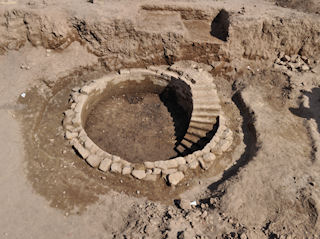
Archaeologists excavating Egypt's Avenue of Sphinxes announced this week that they have uncovered the remains of a nilometer, used to monitor the water level of the Nile.
The Avenue of Sphinxes, built by the 30th Dynasty king Nectanebo I (380-362 BC), was one of the most important processional routes in ancient Egypt. At 2700 metres long and 76 metres wide, it ran between the Luxor and Karnak temples, and was lined with statues in the shape of sphinxes.
Strange place for a depth gauge? Not really. The Egyptians were dependent on water and silt from the Nile's annual flood for their agriculture, and monitoring the river's level told them whether to expect famine, bountiful crops, or devastating floods in the months ahead. They used various devices to do this for more than 5000 years (until the Aswan Dam rendered the practice obsolete in the 20th century).
The first nilometers were simple marks on the riverbank, or on a column or post placed in the river. Later the Egyptians used steps leading down into the water, with depth markings alongside (see video). Then they got more sophisticated, with a channel leading away from the river into a dedicated well or cistern. Any knowledge about what the Nile was going to do was incredibly valuable, so these wells were often located inside temples, accessible only to priests or rulers.
The nilometer found at the Avenue of Sphinxes seems to be of this last type - it is a 7-metre-diameter cylindrical well dug into sandstone, encircled by a spiral staircase (see image). Clay vessels found at the bottom have helped the archaeologists to date it to the New Kingdom (1569-1081 BC).
The team has also found a 1600-year-old Christian church. It was built with limestone blocks recycled from ancient temples that stood along the route - the blocks are still decorated with scenes of Ptolemaic and Roman kings offering sacrifices to ancient Egyptian gods.